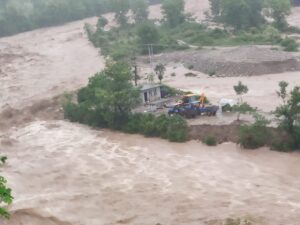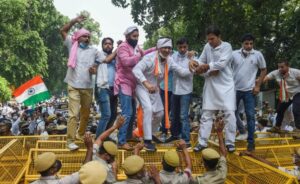After being in a hiatus since June 19, as the monsoon revives and rainfall picks pace in the country, flash floods have been reported in Dharamshala area of Kangra district in Himachal Pradesh due to very heavy rainfall. It is claimed that a cloudburst event has led to these floods.
As per the India Meteorological Department’s (IMD) rainfall data, on July 12 (rainfall recorded from 8:30 am on July 11 to 8:30 am on July 12), the state received a whooping 130 per cent ‘large excess’ rainfall, which has predictably induced massive flash floods.
#WATCH Around 10 shops damaged as Manjhi River rages following heavy rainfall in Himachal Pradesh's Dharamshala pic.twitter.com/m98H2O6Ank
— ANI (@ANI) July 12, 2021
There are reports of cars being washed away in McLeod Ganj hill station near Dharamshala and the national highway being blocked near Jhakri in Shimla’s Rampur area. Manjhi river in Dharamshala is in full spate. The IMD has issued an ‘orange’ weather alert for July 12-13 and ‘yellow’ alert for July 14-15 in the state.
Yesterday, on July 11 also, Himachal Pradesh received an excess rainfall of 69 per cent, shows the IMD data. As against its normal rainfall of 8.3 millimetre (mm), the Himalayan state received 14mm rainfall on July 11.
हिमाचल प्रदेश में तेज बारिश से आयी प्राकृतिक आपदा के संबंध में मैंने मुख्यमंत्री श्री @jairamthakurbjp जी से बात की है। राहत कार्यों के लिए NDRF की टीमें शीघ्र वहाँ पहुँच रही हैं। गृह मंत्रालय स्थिति को निरंतर मॉनिटर कर रहा है। केंद्र की ओर से हिमाचल को हर संभव मदद दी जाएगी।
— Amit Shah (@AmitShah) July 12, 2021
Rainfall variation in Himachal Pradesh
Between 8:30 am on July 11 and 8:30 am on July 12, seven districts of Himachal received ‘large excess’ rainfall (see map below). These include Chamba (80% large excess rainfall), Kangra (275% large excess rainfall), Mandi (225% large excess rainfall), Kullu (677% large excess rainfall), Solan (79% large excess rainfall), Shimla (273% large excess rainfall) and Kinnaur (242% large excess rainfall).

In the same period, Sirmaur district received 34% excess rainfall and Hamirpur received minus 17 per cent rainfall. Lahaul & Spiti district received ‘deficient’ rainfall of minus 40 per cent, and Una and Bilaspur received ‘large deficient’ rainfall of minus 96 per cent and minus 85 per cent, respectively.
Incessant monsoon rains in #Dharamshala’s Bhagasu reportedly triggered a flash flood. The water flooded streets and was seen sweeping away several vehicles in videos that appeared on social media.
— Himachal Watcher (@HimachalW) July 12, 2021
Read More: https://t.co/c9XeZyE8So#HimachalPradesh #FlashFlood #Monsoon2021 pic.twitter.com/nYAUyMsNob
Floods amid deficient monsoon rainfall
Interestingly, even though the state is now facing flood, in the month of July (July 1 to July 11) it has recorded ‘deficient’ rainfall — a rainfall departure of minus 21 per cent.
Also, since the beginning of this monsoon season, between June 1 and July 12, Himachal has reported rainfall departure of minus 18 per cent. Against its normal rainfall of 187.8 mm, the state has so far received only 154 mm rainfall (till July 12, as reflected in the IMD’s data). A large chunk of this rainfall has been received in the past two days.
District wise rainfall data from June 1 to July 11 shows that of its total 12 districts, only five have received ‘normal’ rainfall, whereas six districts have received ‘deficient’ and one has received ‘large deficient’ rainfall.
Also Read: Delayed monsoon, deficient rainfall affects kharif sowing


















